
您可以使用(至少)两个包来平衡最后一页的两列文档的列长度:balance和flushend。
除了balance需要\balance调用显式命令这一表面差异之外,这两个软件包之间还有什么区别?为什么flushend在已有早期软件包的情况下,却构思了后期软件包()?
答案1
这两个软件包之间的一个重要区别在于脚注的处理在最后一页。两者都没有出色地完成工作,但当's 难以理解flushend时,会给出不错的结果balance。我认为最好使用前者。
相同的两个页面使用了两个包。首先使用flusheend。
第二名是balance。
代码
\documentclass[11pt, a4paper, twocolumn]{article}
\usepackage[top=105pt, bottom=75pt, left=75pt, right=75pt]{geometry}
\usepackage{amsmath, amssymb, amsthm}
\usepackage{xcolor}
\usepackage{tikz}
\usepackage{flushend}
% \usepackage{balance}
\usepackage{lipsum}
%%%%%%%%%%%%%%%%%%%%%%%%%%%%%%%%%%%%%%%%%%%%%%%%%%%%%%%%%%%%%%%%%%%
\newtheorem{thm}{Theorem}[section]
\newtheorem{lem}[thm]{Lemma}
%%%%%%%%%%%%%%%%%%%%%%%%%%%%%%%%%%%%%%%%%%%%%%%%%%%%%%%%%%%%%%%%%%%
\title{A twocolumn document}
\author{flushend}
% \author{balance}
\date{}
\begin{document}
\maketitle
\lipsum[1]
\section{Using either \texttt{balance} or \texttt{flushend}}
\lipsum[2]
\begin{thm}
\lipsum[3]
\end{thm}
\lipsum[4]
Consider the following drawing\footnote{\lipsum[21]}.
\begin{figure}[ht!]
\centering
\begin{tikzpicture}
\draw[thick, fill=blue!50] (0, 0) rectangle (3, 8);
\draw[thick, fill=orange!70, rotate=10] (0, 0) rectangle (3, 8);
\end{tikzpicture}
\caption{Rectangles and colors}
\label{fig:rc}
\end{figure}
\lipsum[5]
% \balance
As a consequence, we have\footnote{Well, well! It appears in an
unexpected place.}
\begin{lem}
\lipsum[6]
\end{lem}
\end{document}






